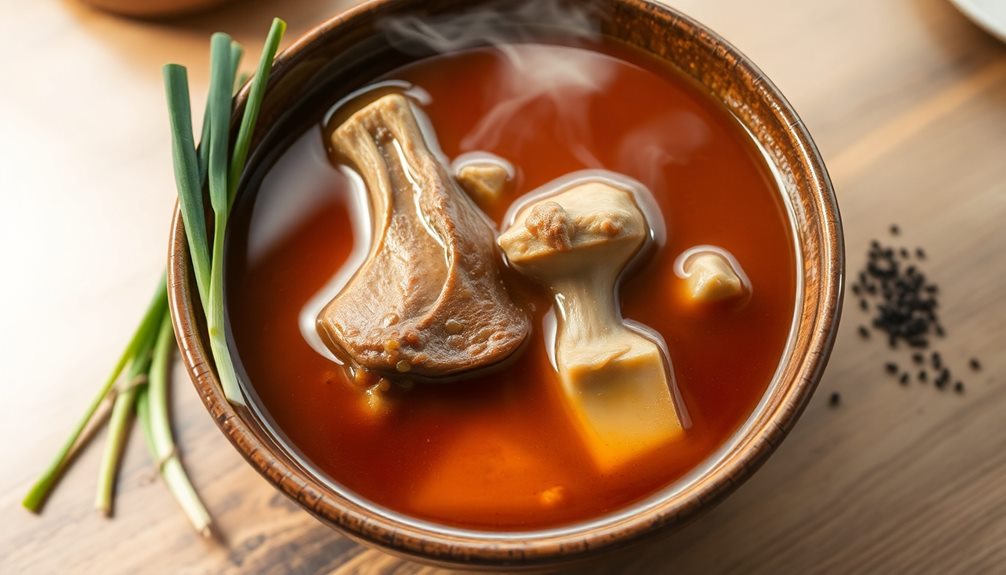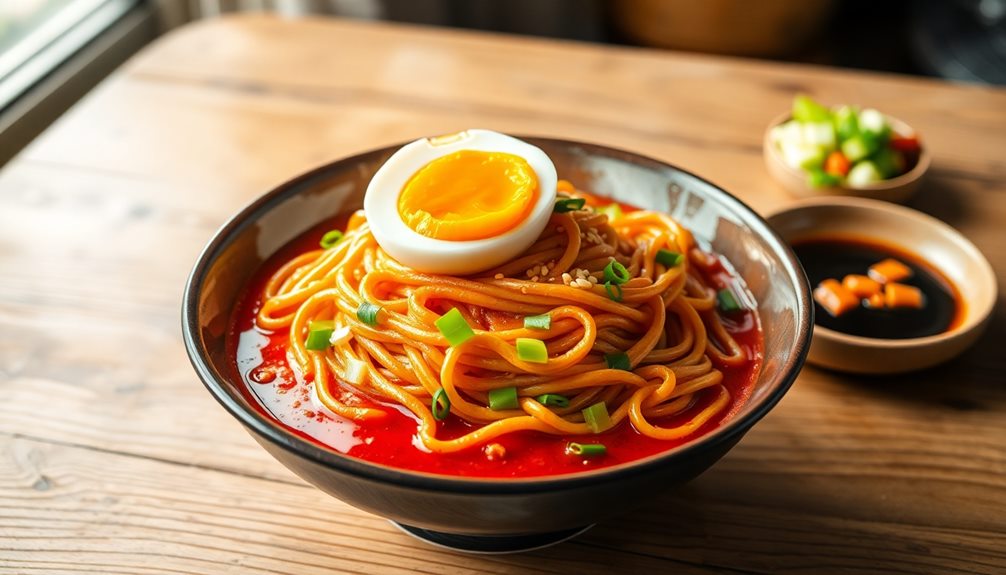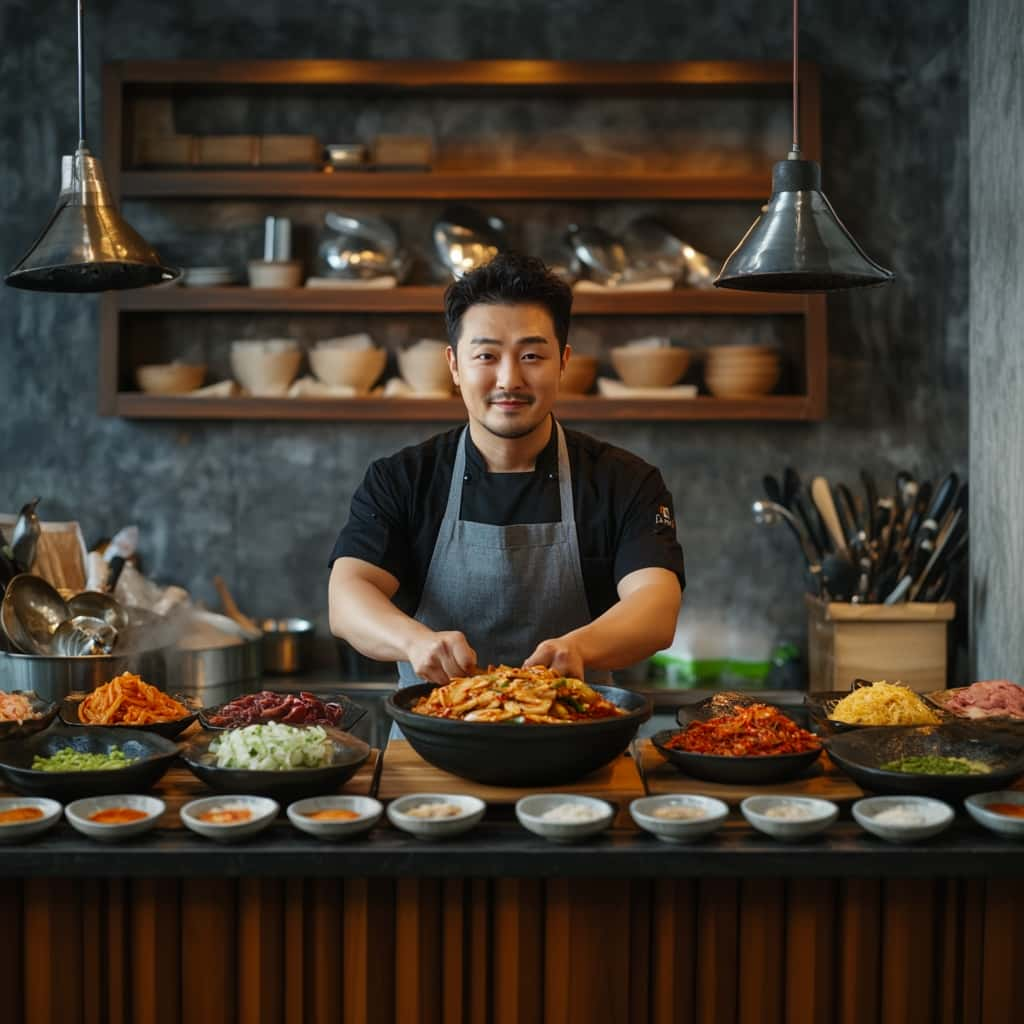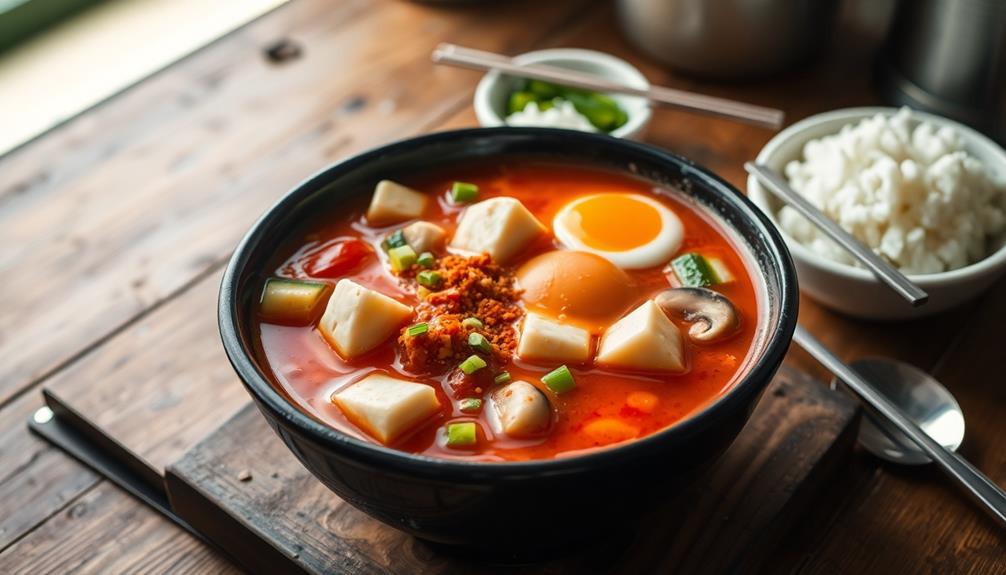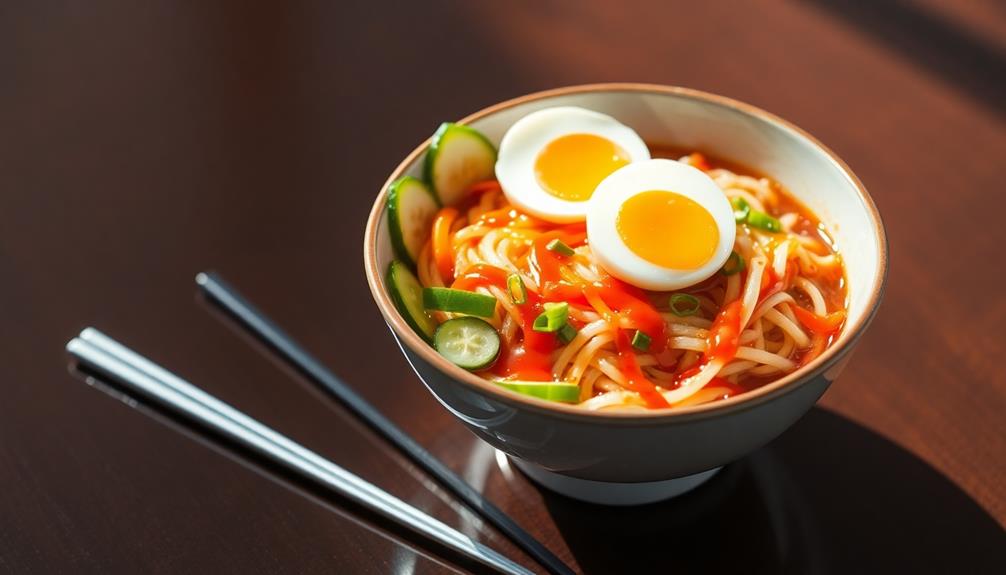Sul Long Tang, Korea's deliciously hearty ox-bone soup, has captivated the hearts and palates of locals and visitors for centuries. You'll discover its humble origins as a meal for common people during the Joseon dynasty, and how it's evolved into a beloved staple, often served for breakfast or as a restorative dish. Each region and family has unique variations of the classic recipe, representing a significant aspect of Korea's culinary heritage. From simmering the bones for hours to garnishing with fresh green onions, the steps to crafting this flavorful soup are sure to impress. And if you're curious to learn more, get ready to dive into the rich history and mouthwatering details of Sul Long Tang.
Key Takeaways
- Sul Long Tang is a traditional Korean ox-bone soup that originated during the Joseon dynasty in the 14th century and has since become a beloved staple dish.
- The soup is prepared by simmering ox bones for hours, skimming impurities, and adding aromatic vegetables like onions, garlic, and radish to create a rich, flavorful broth.
- The broth is simmered for an additional hour to develop a silky-smooth texture and concentrated flavor, with the bones becoming tender and falling off the bone.
- Garnishes like shredded beef brisket, green onions, and sesame seeds are added to the soup, providing a contrast in textures and flavors.
- Sul Long Tang is considered a culinary treasure in Korea, representing a significant aspect of the country's culinary heritage and serving as a comforting, nourishing meal, particularly on chilly days.
History

As one of Korea's most iconic dishes, sul long tang has a rich history that's deeply rooted in the country's culinary traditions.
This hearty ox bone soup has been nourishing Koreans for centuries, with its origins dating back to the Joseon dynasty in the 14th century. Back then, it was a humble meal enjoyed by the common people, made by simmering ox bones for hours to extract the rich, savory broth.
Over time, sul long tang became a beloved staple, often served as a comforting breakfast or restorative dish.
Today, it remains a beloved part of Korean cuisine, with each region and family having their own unique twist on the classic recipe. Today, it remains a beloved part of Korean cuisine, with each region and family having their own unique twist on the classic recipe. One such variation includes the use of a Korean radish paper side dish, which adds a delicate crunch and subtle tang to the meal. This versatile addition highlights the creativity and diversity within Korean culinary traditions, making every dining experience both personal and regional.
Whether you're savoring it on a chilly winter day or looking for a wholesome, satisfying meal, sul long tang is a true taste of Korea's rich culinary heritage.
Cooking Steps
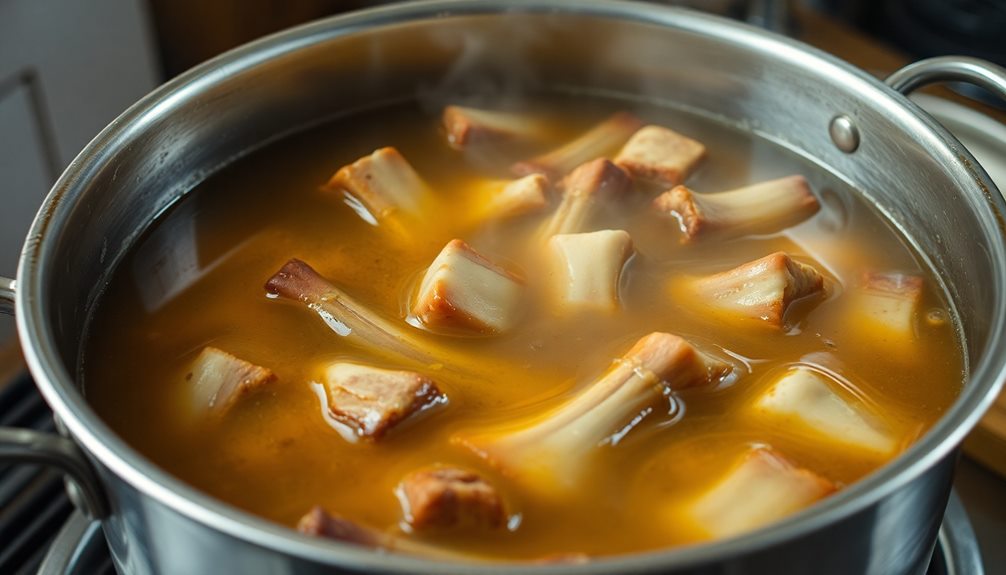
Preparing the hearty ox-bone broth is the first step in crafting this classic Korean dish.
You'll start by simmering the ox bones for hours, coaxing out their rich, savory flavors. Don't forget to skim off any impurities that rise to the surface – this ensures a crystal-clear, flavorful broth.
Next, you'll add fresh vegetables like onions, garlic, and radish to the simmering pot. These will infuse the broth with their aromatic goodness.
Be patient as the soup slowly develops its deep, complex taste. Periodically check the pot and add more water if needed to maintain the perfect consistency.
Once the broth is ready, it's time to prepare the remaining ingredients. Shredded beef brisket, thinly sliced green onions, and a sprinkle of sesame seeds make the perfect toppings for this hearty soup.
Ladle the steaming broth into bowls and let the comforting flavors warm you from the inside out.
Step 1. Soak Beef Bones Overnight

First, you'll want to soak the beef bones overnight. This is a crucial step that helps to remove any impurities and create a clear, flavorful broth.
Gather the ox bones, place them in a large pot or container, and cover them completely with cold water. Let them soak for at least 8 hours, or even better, overnight. This allows the bones to release their natural gelatin, which will give the sul long tang its rich and silky texture.
Once the soaking is complete, you'll need to drain the water and give the bones a good rinse. This helps to further purify the ingredients, ensuring your soup will be clean and pure-tasting.
After rinsing, the bones are ready to be used in the next step of the cooking process. Get ready to simmer them low and slow, coaxing out every ounce of that amazing beefy flavor!
Step 2. Boil Bones for 2 Hours
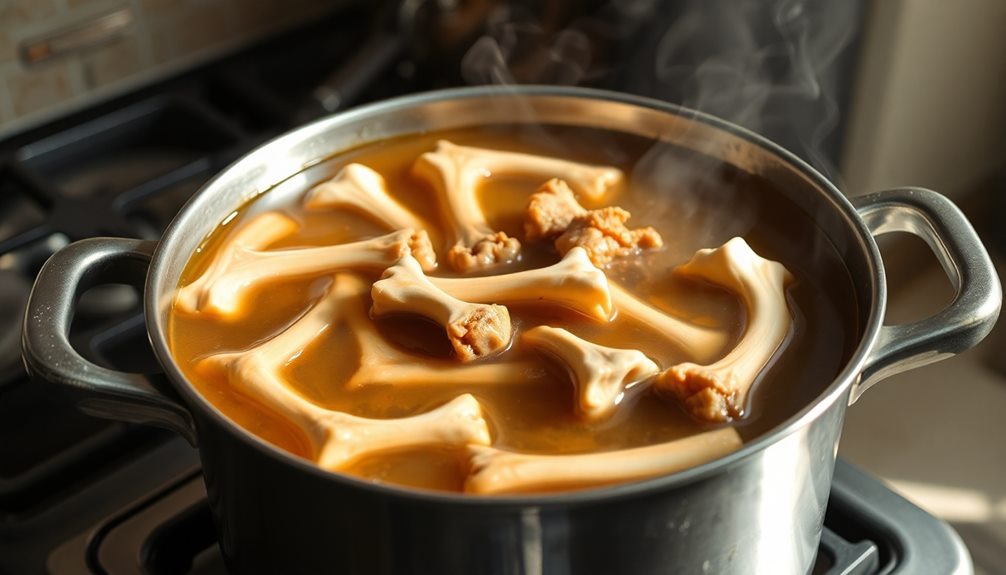
Next, transfer the rinsed bones to a large pot and cover them with fresh, cold water.
Turn the burner to high and bring the water to a boil.
Once it's bubbling away, reduce the heat to a gentle simmer.
Now, let the bones simmer for 2 hours, stirring occasionally.
As the bones cook, you'll notice the water transforms into a rich, golden broth.
This long simmering process is crucial for extracting all the delicious flavors and nutrients from the ox bones.
Be patient – the longer you let it simmer, the more intense and flavorful the broth will become.
After 2 hours, the bones should be tender and the broth will have a wonderfully silky texture.
You're well on your way to creating an authentic, soul-nourishing Sul Long Tang!
Step 3. Add Aromatic Vegetables
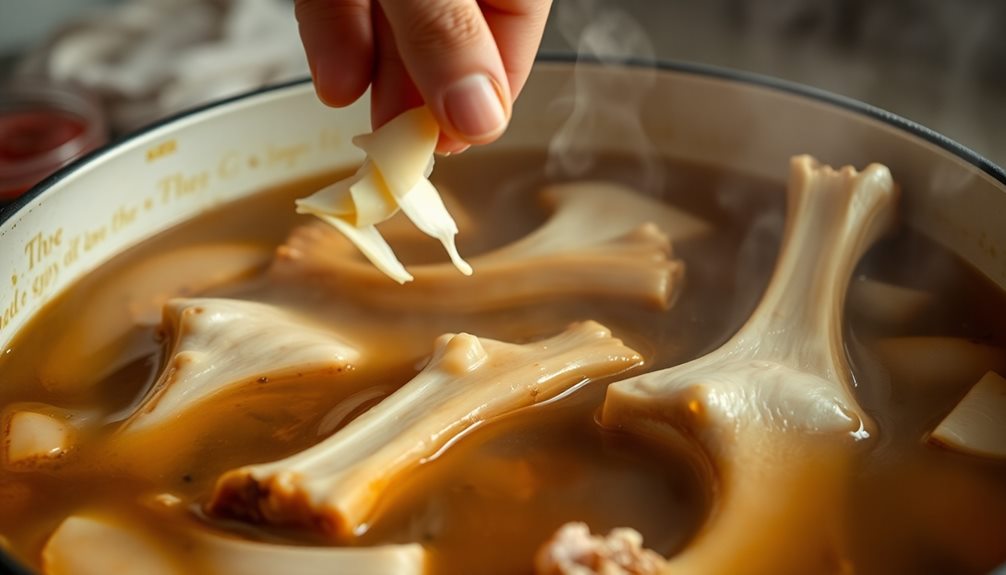
After the bones have simmered for 2 hours, you'll want to add some aromatic vegetables to the broth. This will bring a wonderful depth of flavor to your Sul Long Tang.
Start by chopping up some onion, garlic, and ginger. Toss them right into the pot. The onion will add a sweet, caramelized note, while the garlic and ginger will provide a warm, spicy aroma.
Next, slice up some Asian radish, also known as daikon. This crisp, slightly peppery vegetable will add a delightful crunch to the soup.
Finally, toss in some scallions, sliced into 1-inch pieces. The bright green onions will lend a fresh, herbal taste.
Stir everything together and let the aromatic vegetables simmer for about 30 minutes. This will allow their flavors to infuse the broth, creating a rich, complex base for your hearty ox bone soup.
Get ready for your kitchen to fill with the most tantalizing smells!
Step 4. Simmer for 1 Hour Until Tender
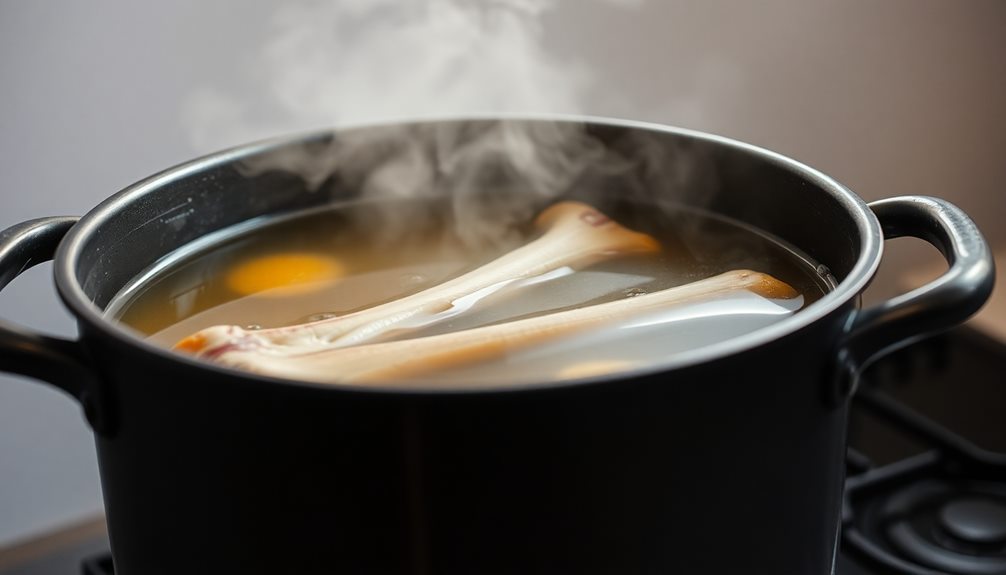
Once the aromatic vegetables have had a chance to flavor the broth, you'll want to let the soup simmer for about an hour. This slow, gentle simmering is key to unlocking the rich, beefy flavor of the ox bones.
As the soup bubbles away, the collagen in the bones will break down, creating a silky-smooth texture and a deep, satisfying taste.
Keep a close eye on the pot, stirring occasionally to prevent any sticking or burning. You'll know the soup is ready when the meat is fall-off-the-bone tender and the broth has taken on a luscious, velvety consistency.
The longer you let it simmer, the more intense and concentrated the flavors will become, so don't be afraid to let it go for the full hour. Just be patient, and let the magic happen!
Soon, you'll have a steaming, soul-warming bowl of Sul Long Tang that's sure to satisfy your heartiest of appetites.
Step 5. Garnish With Green Onions
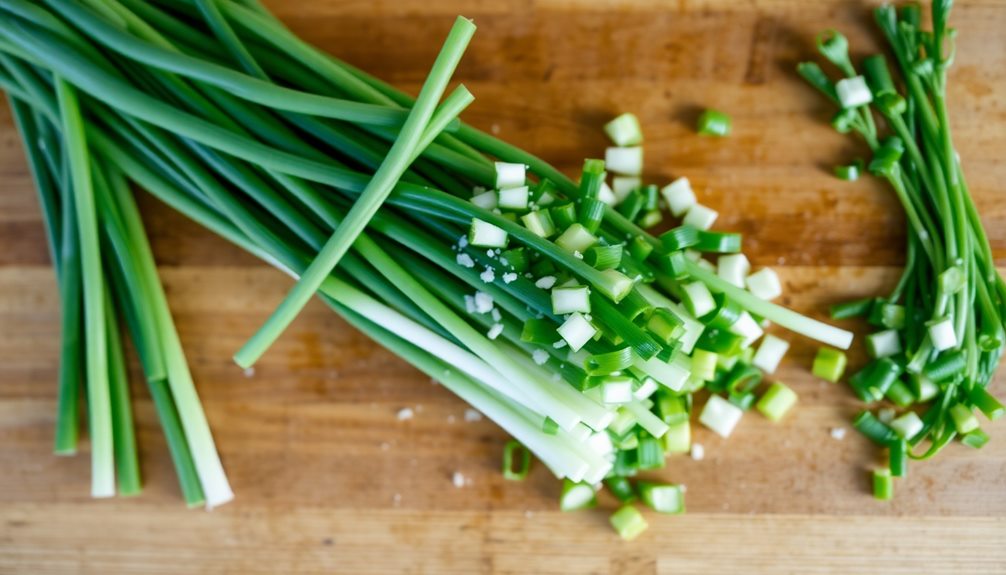
With the soup now simmered to perfection, it's time to add the final garnish.
Grab a fresh bunch of green onions and give them a good rinse. Slice them up into bite-sized pieces, using both the green and white parts. They'll add a lovely pop of color and a delightful crunch to your hearty ox bone soup.
Sprinkle the chopped green onions generously over the top of your steaming bowl of sul long tang. The onions' bright, slightly sweet flavor will perfectly complement the rich, savory broth.
Their crisp texture will also provide a delightful contrast to the tender ox meat and soft noodles.
Don't be shy with the garnish – the more green onions, the better! They'll elevate your sul long tang from a comforting meal to a truly authentic Korean dining experience.
Go ahead, take a big whiff of that aromatic steam, and get ready to savor every last drop of this delectable soup.
Final Thoughts
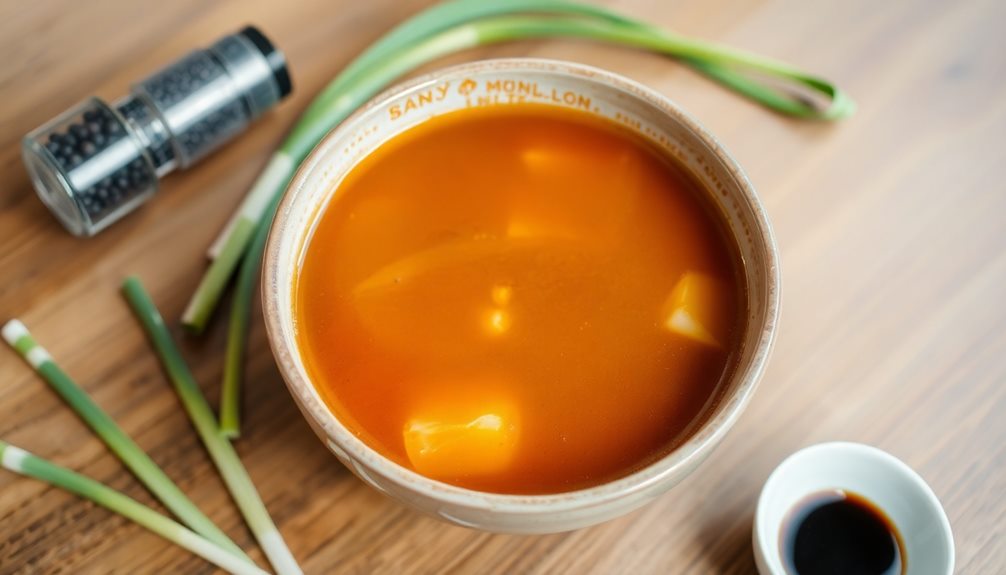
Sul Long Tang, Korea's hearty ox bone soup, is a dish that undoubtedly leaves a lasting impression on those who try it. The rich, savory broth, simmered to perfection with tender beef and aromatic herbs, is a true delight for the senses. As you take your first spoonful, you'll be captivated by the depth of flavor that unfolds on your palate.
What truly sets Sul Long Tang apart is its ability to warm both the body and the soul. The dish's comforting nature makes it the perfect antidote to a chilly day, a nourishing meal that fills you up and leaves you feeling satisfied.
Whether you enjoy it as a hearty main course or a soothing, restorative bowl, Sul Long Tang is a culinary treasure that showcases the best of Korean cuisine. It's a dish that deserves a place in the hearts and kitchens of food lovers everywhere.
Frequently Asked Questions
What Are the Health Benefits of Consuming Sul Long Tang?
Consuming the hearty soup can provide essential nutrients like protein, minerals, and collagen that support bone and joint health. It's also a comforting, flavorful dish that can boost your mood and overall well-being.
Can Sul Long Tang Be Made With Other Types of Meat?
Absolutely! You can make this type of hearty soup with various meats beyond just ox bones. Chicken, pork, or even seafood can be used to create a similarly nourishing and flavorful broth-based dish.
How Long Can Leftover Sul Long Tang Be Stored?
Leftover soup can typically be stored in the refrigerator for 3-4 days or frozen for 2-3 months. Always check for signs of spoilage before reheating and consuming any leftover soup to ensure food safety.
Is Sul Long Tang Suitable for Vegetarians or Vegans?
No, sul long tang is not suitable for vegetarians or vegans. The dish is made with beef bone broth, which is an animal product that's integral to the recipe. You'll need to find a plant-based alternative to enjoy this dish.
Where Can I Find the Best Sul Long Tang in Korea?
Where can you find the best sul long tang in Korea? Look for local establishments, especially in Seoul and Busan, that specialize in this traditional Korean dish. Ask locals for their recommendations to discover the most authentic and flavorful versions.
